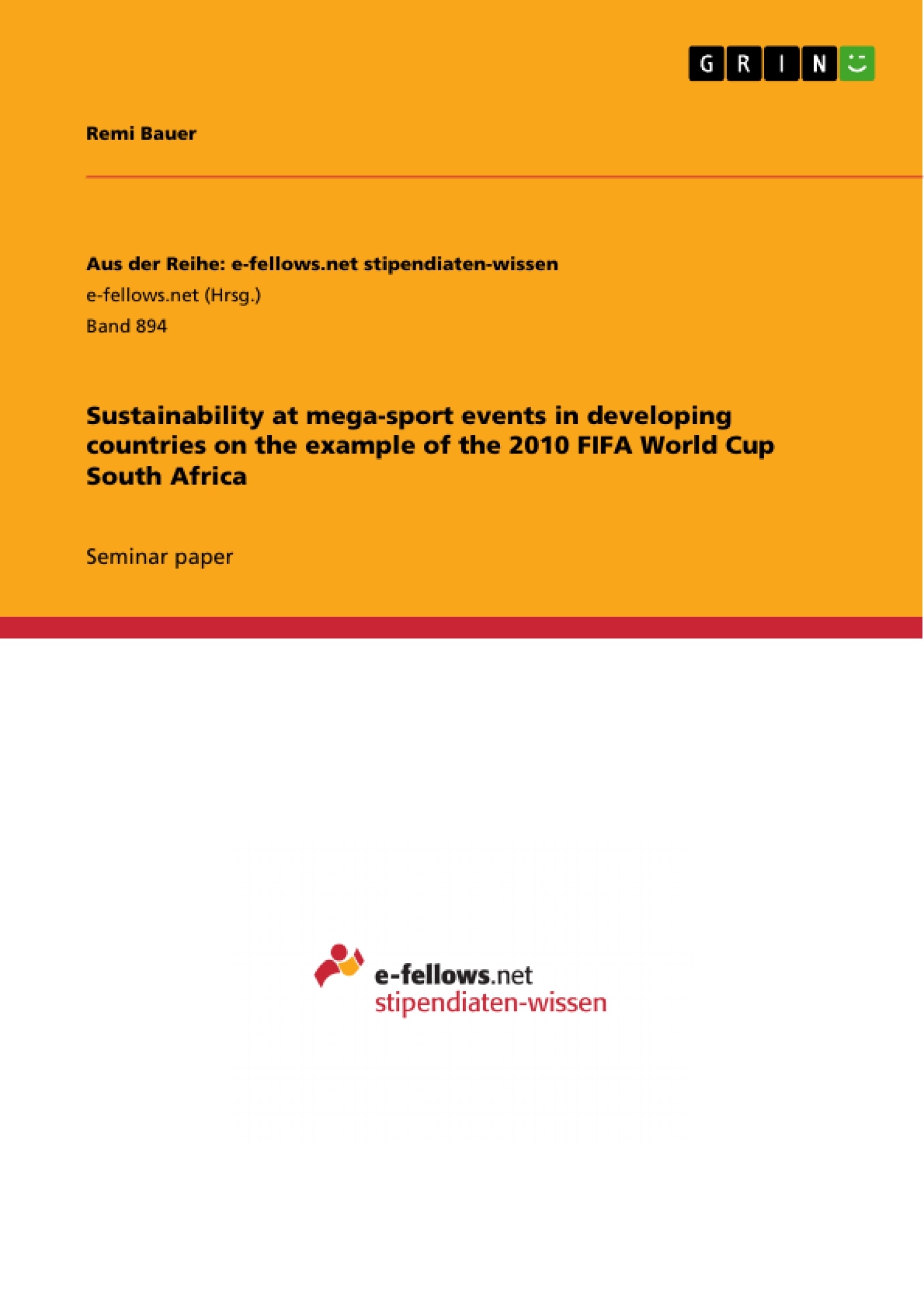With the London 2012 Olympic Games, sustainability within mega-sport events has come to attention again as the organisers of the event are seeking to create a truly green event (London2012 2009a, London2012 2009b). But not only developed nations are hosting such large-scale events. Recently, the FIFA World Cup was held in South Africa, the Commonwealth Games in India and the next Olympics will be staged in Brazil (Konrad-Adenauer-Stiftung 2011). Thus, this paper will deal with the following question. Can sustainability be achieved at mega-sport events in developing countries? The FIFA 2010 Soccer World Championships in South Africa will be used as a descriptive example of a past mega-sporting event. The goal of the paper is to answer this question while also giving a diligent insight and thorough understanding of the Triple Bottom Line Model.
Inhaltsverzeichnis (Table of Contents)
- 1. INTRODUCTION
- 2. SUSTAINABILITY
- 2.1 DEFINITION
- 2.2 SUSTAINABILITY AND MEGA-SPORT EVENTS
- 3. THEORETICAL APPROACH
- 3.1 TRIPLE BOTTOM LINE MODEL
- 3.2 PEOPLE, PLANET AND PROFIT
- 4. 2010 FIFA WORLD CUP SOUTH AFRICA
- 4.1 THE EVENT
- 4.2 TRIPLE BOTTOM LINE
- 4.2.1 PEOPLE
- 4.2.2 PLANET
- 4.2.3 PROFIT
- 4.3 CRITICAL ANALYSIS
- 5. CONCLUSION
Zielsetzung und Themenschwerpunkte (Objectives and Key Themes)
This paper investigates the feasibility of achieving sustainability at mega-sport events in developing countries, using the 2010 FIFA World Cup in South Africa as a case study. It aims to provide a comprehensive understanding of the Triple Bottom Line Model and its application to the context of mega-sport events.
- Defining sustainability and its relevance to mega-sport events.
- Introducing the Triple Bottom Line Model and its three key pillars: People, Planet, and Profit.
- Analyzing the 2010 FIFA World Cup in South Africa through the lens of the Triple Bottom Line Model.
- Exploring the potential for achieving sustainability at mega-sport events in developing countries.
- Assessing the social, environmental, and economic impacts of mega-sport events.
Zusammenfassung der Kapitel (Chapter Summaries)
- Introduction: This chapter sets the context for the paper by highlighting the growing importance of sustainability in mega-sport events and posing the key question of whether sustainability can be achieved in developing countries. The 2010 FIFA World Cup in South Africa is chosen as a case study to answer this question.
- Sustainability: This chapter provides a definition of sustainability and discusses its relevance to mega-sport events. It traces the historical development of sustainable practices in mega-sport events, highlighting the role of the International Olympic Committee and the implementation of initiatives such as Agenda 21 and the Olympic Games Impact Study.
- Theoretical Approach: This chapter introduces the Triple Bottom Line Model as the theoretical framework for the analysis. It defines the model's three key pillars: People, Planet, and Profit, and explains how these pillars contribute to achieving true sustainability.
- 2010 FIFA World Cup South Africa: This chapter provides a detailed description of the event, highlighting its significance as a major sporting event held for the first time in Africa. It also explores the event's potential to leave a positive legacy in economic, social-ecological, and environmental terms.
Schlüsselwörter (Keywords)
Sustainability, mega-sport events, developing countries, FIFA World Cup, South Africa, Triple Bottom Line Model, People, Planet, Profit, social impact, environmental impact, economic impact, legacy.
- Citation du texte
- Remi Bauer (Auteur), 2012, Sustainability at mega-sport events in developing countries on the example of the 2010 FIFA World Cup South Africa, Munich, GRIN Verlag, https://www.grin.com/document/268657



